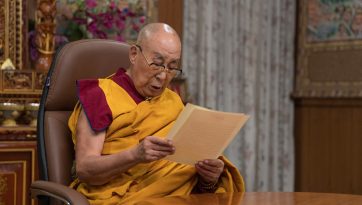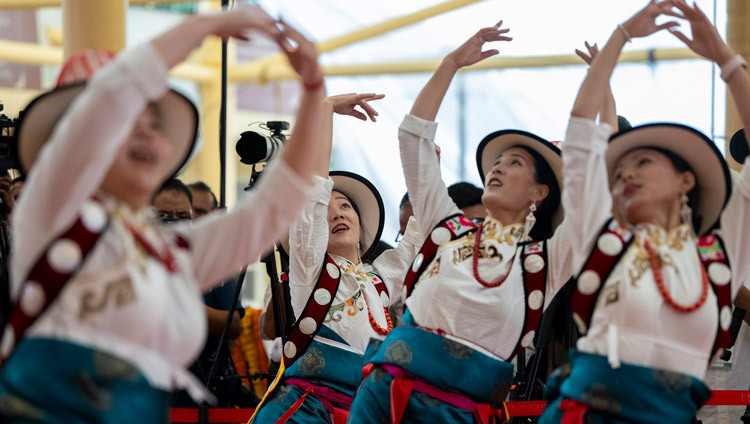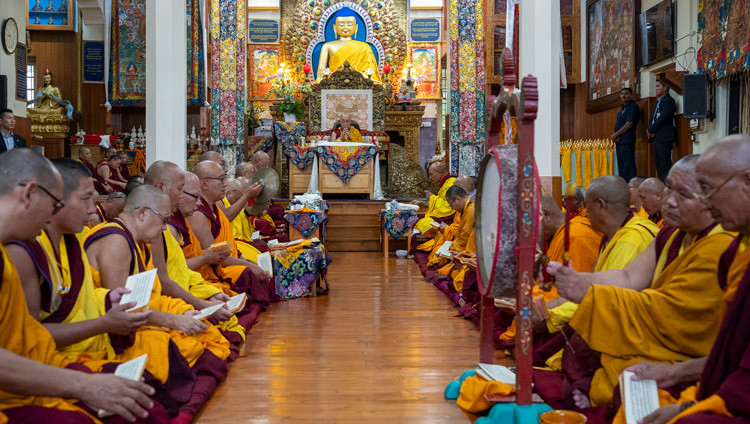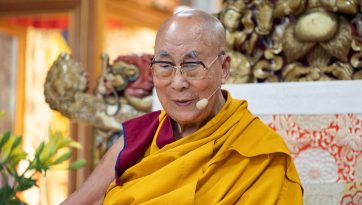Long Life Empowerment at Loseling
December 16, 2019
Mundgod, Karnataka, India – More than 25,000 people, 10,000 of them monks, were packed into the Drepung Loseling debate yard this morning when His Holiness the Dalai Lama arrived by car. He was welcomed by the Abbot, who escorted him to the stage. In the top corner of the yard were assembled two groups of elderly Tibetans. There were about 70 from Mundgod Tibetan settlement, who were more than 85 years old and another 70 or so who are now resident in Canada. His Holiness smiled, waved, spoke to some and touched as many as he could reach, as they offered bowed heads and outstretched hands.
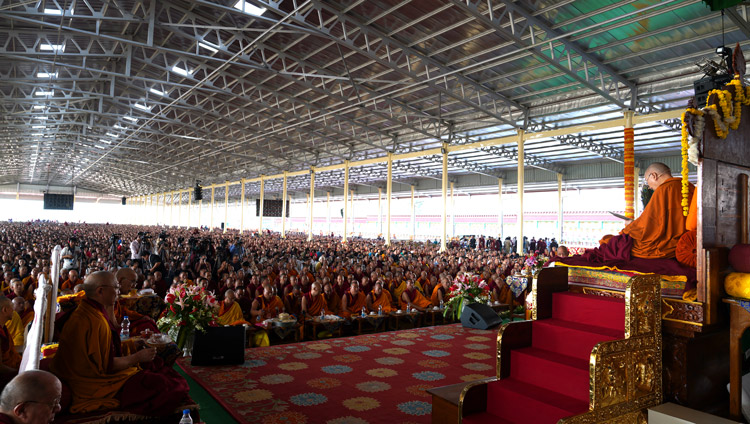
Before the glass-fronted cabinet containing sacred images behind the stage, His Holiness paused to say a prayer and offer a silk scarf before a large thangka of Arya Tara. He lit a lamp before the statues of the Buddha and Jé Tsongkhapa and again offered a prayer and a scarf before another large thangka of White Tara. He waved to old friends among the guests, then waved to the audience left, right and ahead, who responded with a wave of applause. He then saluted the Gelukpa Hierarchs before climbing the steps to sit on the throne.
To His Holiness’s right sat the Ganden Throne-holder, Sharpa Chöjé, Ling Rinpoché, Taktsak Kundeling Rinpoché and Changkya Rinpoché. To his left were the former Ganden Throne-Holder, Jangtsé Chöjé, the Drepung Throne-holder and the Abbot of Drepung Loseling.
His Holiness announced that he needed to perform preparatory procedures for the Long-Life Permission he was going to give and asked the congregation to recite Gendun Drup’s Praise to Arya Tara.
“I’ve previously had the opportunity to teach and address the public in this debate yard,” he told the crowd. “Today, I’m going to give a long-life permission. However, the practice that will really bring you longevity is the attainment of peace of mind. The two practices that will ensure this, the altruistic awakening mind of bodhichitta and a correct view of emptiness, are the essence of the dharma. Blindly repeating prayers to the Three Jewels is not enough, you have to know who or what you are taking refuge in.”
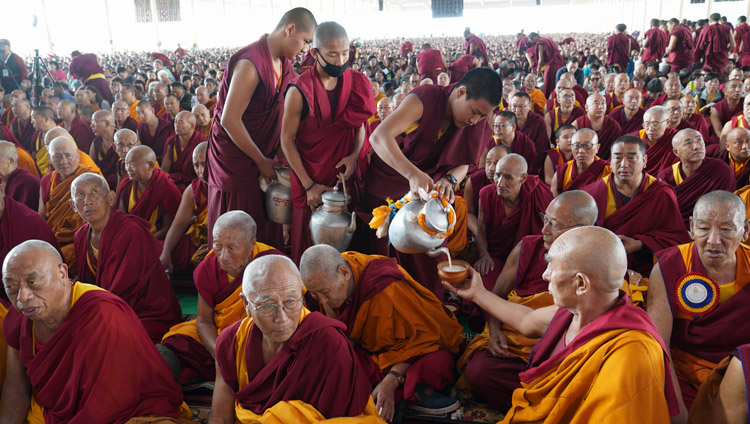
His Holiness quoted stanzas from Nagarjuna’s ‘Fundamental Wisdom of the Middle Way. The work ends with this verse:
I prostrate to Gautama
Who, through compassion,
Taught the exalted Dharma,
Which leads to the relinquishing of all views.
It begins with these verses which indicate that dependent arising is free from eight extremes:
I prostrate to the perfect Buddha,
The best of all teachers, who taught that
That which is dependently arisen is
Without cessation, without arising;
Without annihilation, without permanence;
Without coming; without going;
Without distinction, without identity
And is peaceful – free from fabrications.
“This large gathering includes many guests of Loseling Monastery,” His Holiness continued. “What we all share is that in our infancy we were dependent on our mothers. Without her care and attention, we wouldn’t have survived. We grew up and our brains developed in the security of her kindness.
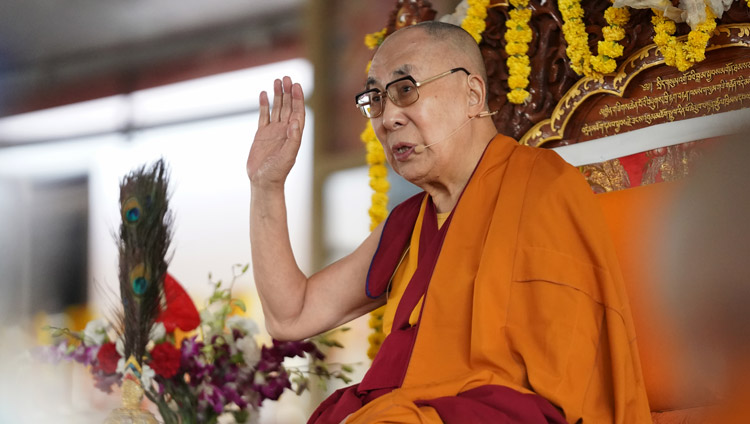
“As children we played together with others in an utterly unprejudiced way. It’s only when we embarked on our education that we began to learn to view others in terms of ‘us’ and ‘them’, which only leads to division. Consequently, we have to train our minds to appreciate that things don’t exist the way they appear.
“The practice of non-violence—‘ahimsa’—has flourished in India for more than 3000 years. The Jain teacher Mahavira advocated it strongly. Later, the Buddha commended non-violence too and taught about the workings of the mind and a correct view of reality on the basis of reason and logic. The Four Noble Truths and the Vinaya that are the core of the Pali traditions and which he explained in his first round of teachings, are upheld by all schools of Buddhism.
“Among the perfection of wisdom teachings that comprise his second round of instructions is the ‘Heart Sutra’ that states, ‘Form is empty; emptiness is form. Emptiness is not other than form; form also is not other than emptiness.’ We can overcome illusion, our misconception of reality, by coming to understand emptiness. But we must identify what such insight negates.
“Many masters of Nalanda dealt with this in their treatises, which were translated into Tibetan and which to this day serve as our textbooks. The reasoning and logic that typifies the Nalanda approach is only preserved among those who follow the Tibetan tradition. The Buddha gave three rounds of teaching in India, but even prior to those, major Indian spiritual traditions upheld ‘ahimsa’ and ‘karuna’, non-violence and compassion.
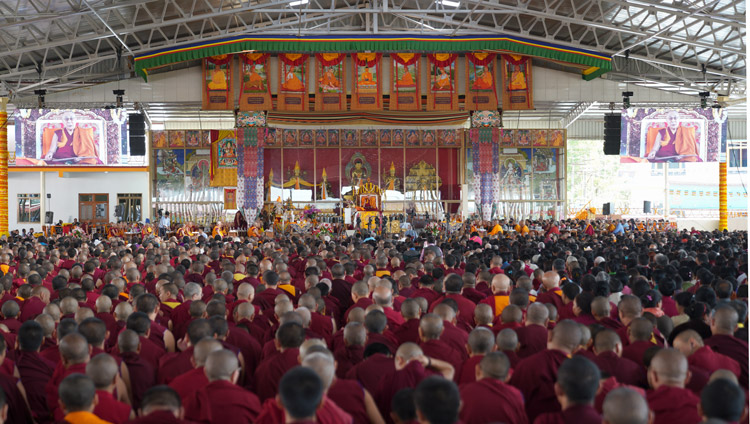
“People across the world have taken an interest in these things since they were revealed to them by members of the Tibetan exile community. The essence of these practices is to be warm-hearted. And warm-heartedness is not only of benefit to others, because it brings you peace of mind.
“The main obstructions to peace of mind are self-centredness and the misconception that something exists truly, independently, and of itself. If this were the case, we should be able to find it when we search for it under analysis—but we don’t. Quantum physics also says that things don’t exist objectively. Because we misconceive how things exist, we have an exaggerated and fabricated view that provokes our disturbing emotions. Consequently, we make problems for ourselves.
“Shantideva describes the bodhisattva’s attitude:
And so, today, within the sight of all protectors,
I summon beings, calling them to Buddhahood.
And, till that state is reached, to every earthly joy!
May gods and demigods and all the rest rejoice!
“When I was asked this morning whether I’d slept well, I said ‘Yes, because thinking of others as more important sets the mind at ease and gives you sounder sleep. When you have an altruistic outlook, everything appears in a more positive light.’”
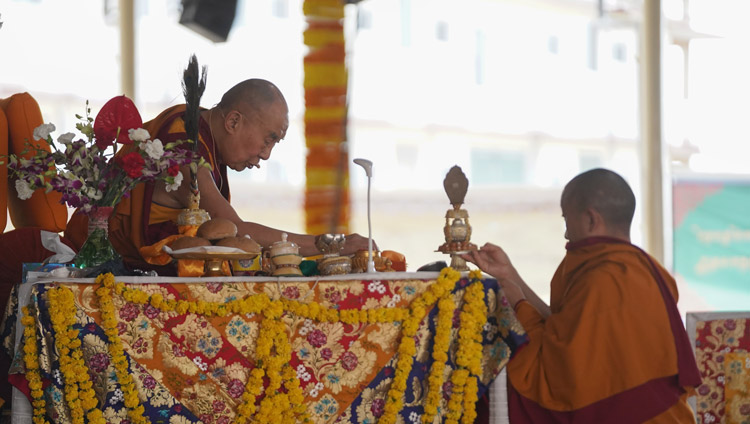
His Holiness mentioned that he originally received the permission he was about to give from Tagdrag Rinpoché. He then addressed the many elderly people in the audience for whom death is an impending prospect. He remarked that many Indian spiritual traditions believe that we live life after life. The body is left behind, but something goes on. Many Indian traditions refer to what goes on as ‘atman’, but Buddhist teaching regards this as reinforcing the misconception of self. Past and future lives are explained in terms of the continuity of consciousness.
“Don’t think of your life as having been fruitless, think of how you have engaged with what the Buddha taught,” His Holiness advised. “However long you live, focus your mind on bodhichitta and insight into emptiness. Reflect on them and be at ease.
“Tibetans are under the guidance of Avalokiteshvara. He’ll care for you in your next life. Those of you who are not Tibetan, but feel close to this tradition will come under his care too. I think of myself as a messenger of Chenrezig and when you die, I’ll take your hand and introduce you to him.”
The longevity permission focussed on Jé Tsongkhapa, who was born near to where His Holiness was born. His Holiness described his written works as incredible. Where he finds Khedrup-jé somewhat conceited, Jé Rinpoché is consistently modest. And whereas Butön Rinchen Drup is highly regarded for his scholarship, His Holiness finds he tended to gloss over difficult points in the classic texts, while Tsongkhapa went to great lengths to explain them.
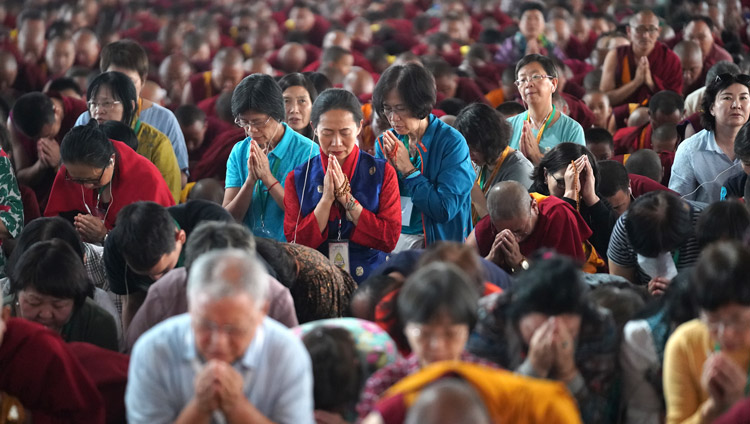
As part of the Long-Life permission, His Holiness led the congregation is generating the awakening mind of bodhichitta and taking the bodhisattva vows. He counselled that cherishing others more than yourself is the source of all happiness, adding that it is also necessary to develop bodhichitta to overcome the obscurations to knowledge.
While he performed the rites to conclude the ritual, His Holiness asked the audience to recite the ‘Prayer for the Flourishing of Jé Rinpoché’s Teachings’. He then ate lunch with the Ganden Throne-holder, the Sharpa and Jangtsé Chöjés, the former Ganden Throne-holder and several other pre-eminent Lamas of Drepung Loseling in a room behind the stage, before returning to his quarters above the Assembly Hall.

